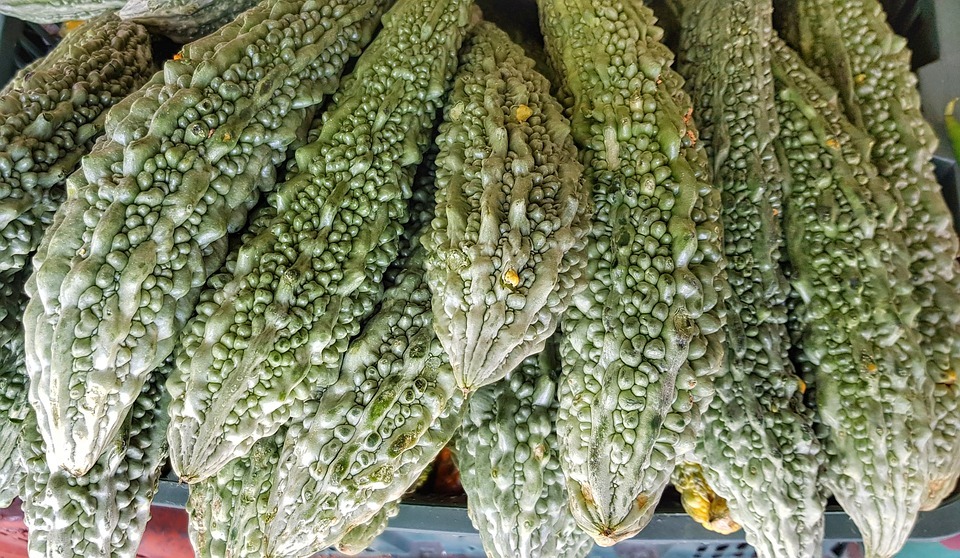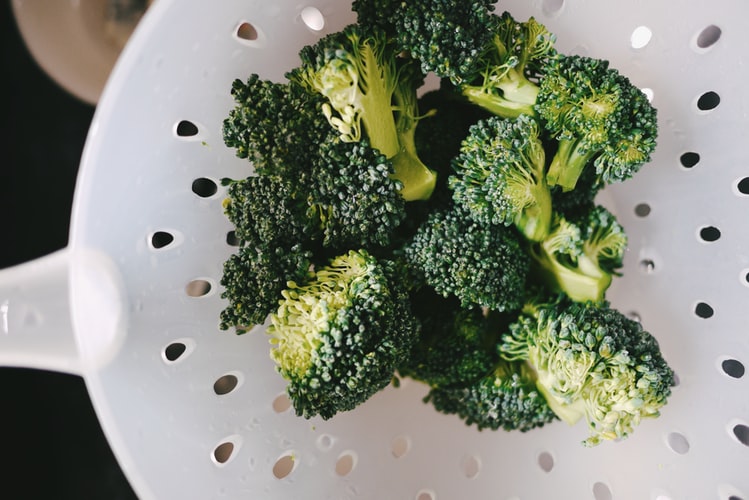Tapioca Root Juice: A Mild and Starchy Juice Full of Fiber
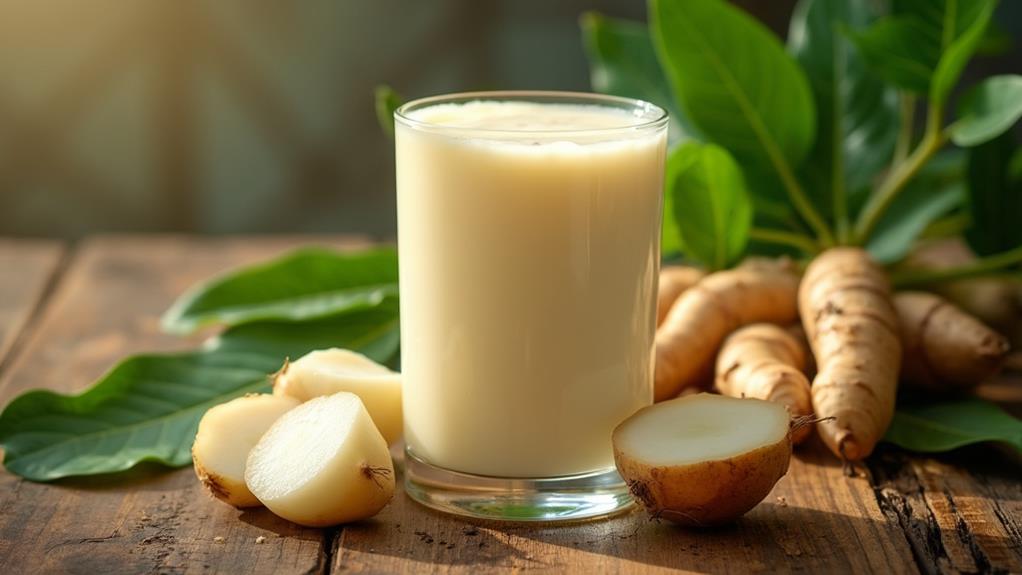
Tapioca root juice originates from the cassava plant and offers a mild, starchy drink that's naturally gluten-free and rich in carbohydrates. It's a fantastic energy source without altering the flavor of beverages or dishes, making it ideal for smoothies and gluten-free baking. Despite its minimal fiber content, it supports digestive comfort and provides steady energy. However, verify proper processing to avoid potential toxicity from cyanogenic glycosides. With its low protein and fat content, it fits diverse dietary needs, although moderation is key due to its high calorie content. There's more to uncover about this versatile juice's benefits and potential applications.
Origin of Tapioca Root
Originating from the cassava plant, tapioca root has deep roots in South America's agricultural history, cultivated for thousands of years. This root, rich in starch, is a powerhouse of carbohydrates, crucial for providing energy. You'll find that cassava thrives in tropical and subtropical climates, which has helped it spread across continents like Africa, Asia, and parts of the Caribbean. This adaptability makes it a significant crop in discussions about food security, especially because cassava can withstand drought and grow in poor soil conditions.
As you explore the culinary world, you'll see that cassava is often processed into different forms such as tapioca pearls, flour, and flakes. These products are staples in many kitchens, used in a variety of dishes from sweet puddings to savory breads. Despite being low in fiber, the versatility of tapioca makes it an important ingredient across multiple cultures. Its role in culinary applications is widespread, offering both texture and flavor to a range of recipes. By understanding the origin of the tapioca root, you can appreciate its progression from a humble tropical root to a global culinary staple.
Extraction Process of Juice
Peeling and chopping the cassava roots is the initial step in extracting tapioca root juice. Once you've got the cassava roots prepped, soaking them in water is vital. This soaking process softens the roots, releasing their starchy juice. After the cassava becomes pliable, you'll want to grind or grate it to form a pulp. Then, grab a cloth or fine mesh sieve to squeeze out the starchy liquid from this pulp.
During this extraction process, it's important to be cautious about the presence of cyanogenic glycosides in cassava roots. If not adequately processed, these compounds can turn into toxic cyanide. Ensuring proper treatment of the root safeguards your juice.
Once you've extracted the starchy juice, allow it to settle. The starch sinks to the bottom, separating from the liquid. You can discard this liquid or find other uses for it. The resulting tapioca root juice has a mild flavor and a rich, starchy consistency. It's perfect for numerous culinary applications, especially if you're exploring gluten-free recipes. With its unique properties, tapioca root juice can improve your dishes, adding both texture and flavor.
Nutritional Composition
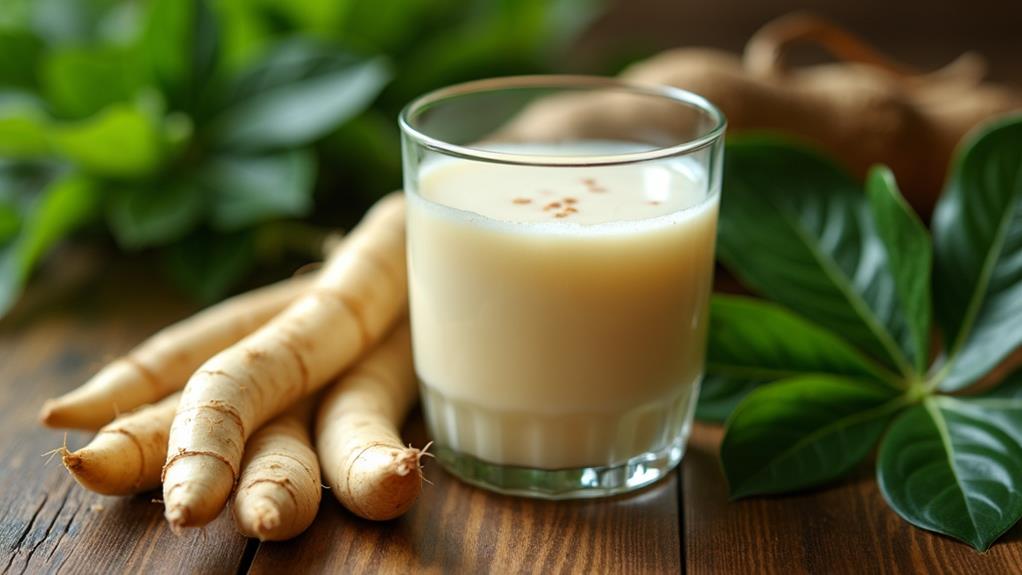
Although tapioca root juice is known for its high carbohydrate content, it provides a concentrated source of energy with about 135 grams per cup. This makes it an excellent choice if you're looking for an energy enhancement. Despite its high carbohydrate profile, the juice is low in protein, offering just 0.29 grams, and contains a mere 0.03 grams of fat per cup, making it a low-fat option. This starchy juice is naturally gluten-free, so it's perfect if you have celiac disease or gluten sensitivity.
While tapioca root juice provides a mild and pleasant flavor, it's essential to recognize that it's low in fiber, with only about 1.37 grams per cup. This low fiber content might not support digestive health in the same way as whole fruits and vegetables. However, it compensates for this by offering important minerals. One cup delivers approximately 30.4 mg of calcium, necessary for maintaining bone health, and 2.4 mg of iron, critical for oxygen transport in your body. These minerals make tapioca root juice a beneficial supplement to your diet, providing nutrients that support general health while offering a unique taste experience.
Health Benefits
Tapioca root juice, extracted from cassava, offers more than just a unique taste and nutritional profile; it comes with a host of health benefits that make it an appealing supplement to your diet. Rich in carbohydrates, this juice provides a quick energy enhancement, making it ideal for those with active lifestyles. It's also low in fat, which supports weight management and contributes to comprehensive heart health. As a gluten-free option, tapioca root juice is especially beneficial for individuals with celiac disease or gluten sensitivities, offering a safe and nutritious alternative.
Beyond energy and gluten-free benefits, tapioca root juice contains moderate dietary fiber, which plays an essential role in promoting digestive health. Though its fiber content might be lower than some other sources, it aids in maintaining stable blood sugar levels by allowing gradual digestion. This makes it a smart choice for those looking to manage their blood sugar without the spikes associated with high-fiber foods. The combination of its low-fat profile and gradual energy release means you're less likely to experience drastic energy fluctuations, making it easier to manage your weight while enjoying a healthy, balanced diet.
Digestive Advantages

Regarding digestive health, tapioca root juice stands out as a gentle and effective option. Its starchy carbohydrates provide a quick energy enhancement while being kind to your digestive system. Unlike many grain or nut-based alternatives, tapioca root juice features a low fiber content, making it easier to digest. This can be particularly advantageous for those with digestive sensitivities or conditions like irritable bowel syndrome (IBS). The mild nature and low FODMAP profile of this juice mean you can enjoy it without worrying about digestive discomfort.
Here's how tapioca root juice can benefit your digestive health:
- Resistant Starch: It promotes the growth of beneficial gut bacteria, supporting a healthy gut environment.
- Low Fiber Content: Its ease on the stomach makes it suitable for those needing a gentle option.
- Mild Nature: Perfect for those with IBS, reducing the risk of flare-ups.
- Moderation: Enjoying it in moderation provides energy and calories without the heaviness of high-fiber options.
Culinary Applications
Having examined the digestive benefits of tapioca root juice, let's now consider its culinary versatility. As a starchy liquid extracted from cassava roots, tapioca root juice works wonders as a base for soups and sauces. Its role as a thickening agent improves texture, making your savory dishes rich and satisfying. Thanks to its neutral flavor, you can blend it with different ingredients without altering the taste, making it ideal for smoothies and other beverages that need a bit of extra thickness.
In the world of desserts, tapioca root juice shines brightly. Use it to create indulgent puddings where the starch content delivers an unbeatable creamy consistency. If you're exploring gluten-free baking, this juice is your ally, providing moisture and improving the structure of breads and pastries, ensuring they turn out just right.
Asian culinary traditions frequently incorporate this adaptable ingredient. You'll find it adding a subtle sweetness and chewy texture to bubble tea and a range of desserts. Regardless of you're making a classic dish or trying something new, tapioca root juice offers endless possibilities, enriching your creations with its unique properties. Immerse yourself in its culinary applications and uncover its many uses!
Gluten-Free Qualities
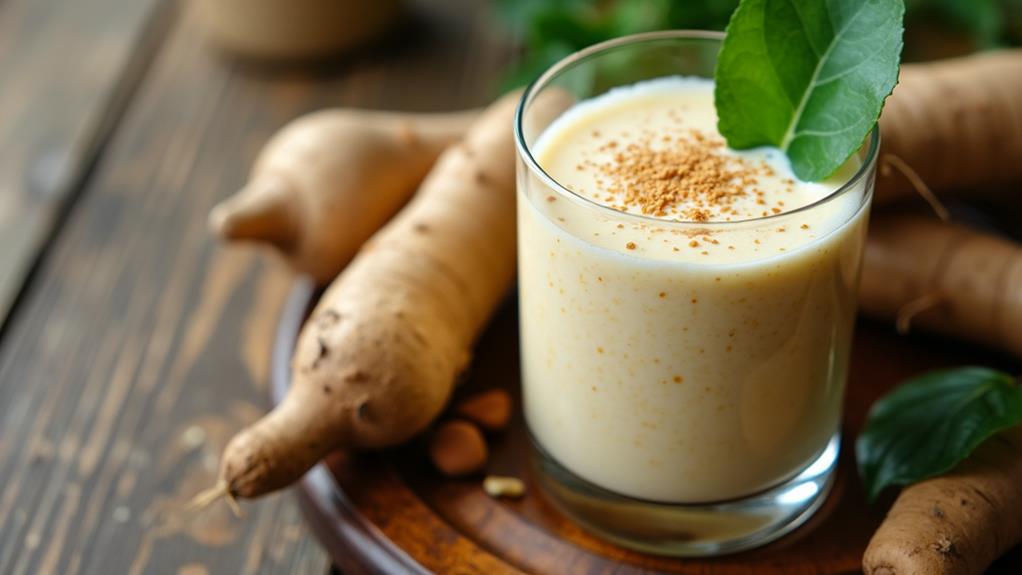
For those traversing a gluten-free lifestyle, tapioca root juice offers a revitalizing and versatile option. Derived from cassava, this juice is naturally gluten-free, making it a safe choice for anyone with celiac disease or gluten sensitivity. It's packed with almost pure starch, ensuring a carbohydrate-rich drink that provides energy without the unwanted gluten proteins. If you're managing dietary restrictions, tapioca root juice seamlessly fits into your gluten-free diet, offering vital calories while keeping fat and protein to a minimum.
The gluten-free qualities of tapioca root juice open up a world of culinary possibilities. Here's how you can incorporate it into your meals and treats:
- Beverages: Mix it into smoothies for a creamy texture and a burst of energy.
- Desserts: Use it as a base for puddings, adding a smooth, starchy element.
- Baking: Substitute it in recipes for gluten-free muffins or cakes to maintain moisture.
- Sauces: Thicken sauces or soups with it, enhancing flavors without gluten.
With its rich starch content and versatility, tapioca root juice is perfect for creating delicious gluten-free beverages and desserts while ensuring you meet your dietary needs.
Potential Side Effects
While tapioca root juice offers numerous benefits for those on a gluten-free diet, it is vital to be aware of potential side effects. One significant concern is the presence of cyanogenic glycosides. If the juice isn't properly processed, these compounds can convert to cyanide, posing severe health risks if consumed excessively. Confirm the juice is adequately prepared to avoid this danger.
Additionally, the high carbohydrate content and high glycemic index of tapioca root juice can lead to increased blood sugar levels. This is particularly concerning for individuals with diabetes, as it may exacerbate their condition. Also, the juice's low fiber content can cause digestive issues if it is a primary dietary component without other fiber sources. Digestive discomfort or bloating may occur, especially in those sensitive to starchy foods.
Overreliance on tapioca root juice as a dietary staple can lead to nutritional deficiencies. The juice lacks significant protein and important micronutrients, which are vital for maintaining complete health. Consuming it in moderation and combining it with other nutritious foods can help mitigate these risks and guarantee a well-rounded diet.
Consumption Tips

When incorporating tapioca root juice into your diet, it's vital to enjoy it in moderation due to its high calorie and carbohydrate content. This calorie-dense beverage, with around 544 calories per cup, provides a significant energy increase thanks to its 135 grams of carbohydrates. However, to maintain a balanced diet, consider these tips:
- Blend for Flavor and Nutrition: Improve the taste and nutritional value by blending tapioca root juice with fruits or vegetables rich in vitamin C. This not only enhances the flavor but also aids in iron absorption, which is important for maintaining healthy blood levels.
- Use as an Appetite Manager: The high fiber content in tapioca root juice helps promote a feeling of fullness. Incorporating it into your meals could assist in managing appetite, making you less likely to overeat later.
- Pair with Nutrient-Dense Foods: Balance the calorie-dense nature of tapioca root juice by pairing it with nutrient-dense foods. This guarantees you're getting a well-rounded intake of vital vitamins and minerals.
- Moderation is Key: Enjoy this starchy juice occasionally rather than daily to keep your diet balanced and prevent excessive calorie intake.

